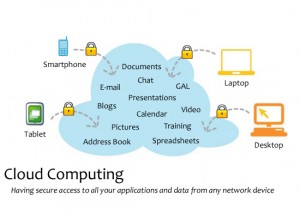
Image: Google Man/Wikimedia
Cloud computing, like a thunderhead, is abuzz with energy. From Apple’s iCloud to Best Buy’s new cloud music service, companies are scrambling to up the ante on their cloud offerings.
Despite all the hype, it’s not common knowledge what the cloud actually is. We all know that the cloud is exciting, but the whys and hows of it seem relegated to esoteric IT realms.
Perhaps one reason for that lack of public comprehension is that the cloud is so customizable. Take Egnyte, an SMB-oriented cloud platform that lets you store data, share files, centralize company information, open up cross-platform mobile access, and more. As a cloud-based service, Egnyte saves you the time and money associated with building out an IT structure, laboring to put a hacked file server back together and upgrading servers. Essentially, Egnyte gives you a flexible, cost-effective platform. How you use Egnyte is up to you, however, and that’s where it helps to know more about the cloud than the usual “get on it” mantra.
I caught up with Egnyte co-founder and CEO Vineet Jain, who helped design the powerful platform from the ground up, to de-fog some ideas around cloud computing. He talked about working around the psychological challenges that come up with using the cloud, its real security holes, in what direction the trend winds are blowing the cloud, and more.
Can you tell me a little bit about the challenges associated with using the cloud?
Even when I started the company, I knew that a pure cloud-based service will only go so far. That’s because you’re trying to address something that is traditionally run in your firewall in your local area network. A pure cloud-based platform for something that data-intensive will always have technical and psychological challenges.
The technical part is the latency challenge. When you’re dealing with extremely large files—let’s say you’re a web design firm and you work on Adobe Illustrator files or Photoshop files—when these files are hosted in somebody’s cloud server, in this case us, they will never match the speed you will get in your local area network. We’re dealing with the public internet (Ed.: which is slower than a LAN).
The other big problem always seems to be that when the internet service is down, if I am an SMB, I am dead in the water. I cannot access my corporate data. Even if that problem exists for only three minutes, it has a pretty significant impact on my business.
But the biggest problem I still see is more psychological. That is the perception that I, as a company, am not in control of my data because my files are hosted on somebody else’s server, in this case Egnyte’s. Even though that server may provide much better security and redundancy, there is still this sense that I am losing control of my data.
I think that is a psychological barrier that a lot of businesses are still exhibiting. They want something that they can touch, literally speaking, something that is locally available, for their peace of mind.

Image: B Rosen/Flickr
How did you adapt Egnyte to address those problems?
I was aware of this combination of problems from day one. After fourteen months in existence with a pure cloud file server solution, we introduced an adjunct product, sort of an extension. We call it the local cloud.
It’s a little bit of an oxymoron. Essentially, we give you a local copy or a local cache of your data, on commodity hardware, which will span all the way from a low-end computer hard drive–a low-level solution like a drop box–to commercial off-the-shelf network-attached storage (NAS) devices that you would get from the likes of Netgear, and including now virtual appliances that you could pretty much deploy in any existing piece of hardware.
The whole idea is that we have evolved cloud into a hybrid solution. It is attracting a much larger customer accounts than we would have been able to if we only had a cloud-based solution. People get the best of both worlds. They combine the ease of use of the cloud with the fast local performance of a LAN. Theyhave a local copy of their sensitive data and control access rights. My employees have a local cloud folder on their desktop that looks like an Explorer file folder, and they don’t really care how the files are being served. When they are sitting in the office, thefiles are served from the local cloud and when they are at home or remote, the files will be served from the cloud file server. Whether you access your files on the cloud or locally (unbeknownst to you), the same file access rules are enforced. We have taken away the complexity of giving you fast performance, as well as any-device,any-location access with this hybrid cloud solution.
How do you think people are using the cloud in one way that they’re not? Are there some technologies that people use off the cloud that you think should be migrated to the cloud?
I’d like to see people who are used to software that runs within the firewall using the cloud more. Quickbooks is an example. A lot of small businesses use Quickbooks. A few years back, I was at Intuit and they invited me to a usability session and would pay me $200 an hour for being there, and I thought, I’ll go and try it out. So they were teaching Quickbooks online as a substitution. Yet even today, Quickbooks is still selling more of the package desktop software than the online version. So why is online not taking off? For the amount of usability or the feature richness that the desktop version has, it’s still does not match what they have online. So in this particular case, the desktop or the old style still rules.
The cloud is a big change in peoples’ habits. For certain kinds of applications where they’re still not willing to go to the cloud. It’s a very interesting mix. It depends on which application, which area we are talking about, to say are people using the cloud properly or not.
It’s not simple answer is what you’re saying, right?
Right. When you look at Egnyte, what do people use Egnyte for? We have some people who use every nook and cranny of Egnyte, every feature, they use it as a full replacement for their web- and file servers. Some people use Egnyte for simple file sharing. They still have an internal file service, they still have VPN for remote access for their employees. But when it comes to external, project-based collaboration, they use Egnyte as an add-on to what they currently do. But they don’t replace other things they have. I could try to ask them “why are you wasting so much money doing it all yourself, you can put everything into my solution.” But it’s just a mindset, what is the comfort level? So it’s hard to say how I should advocate people to use the cloud, it’s very subjective.
You’ve talked about the fact that people get used to their desktops and servers, that they have psychological objections to the cloud. What are the actual security risks associated with the cloud? What should people be worried about?
There are several types of security. People should be worried about access security. Many cloud server solutions do not have the robust user access controls and audit reports required to enforce business policies.They should also be worried about transmission security. Not only is there encryption needed at storage, but there’s encryption during access,. The transmission should be secure with a mobile device as well as with a PC and wired network connection.
Another risk that I think people should evaluate is what happens if a provider is not online. The internet provider could go down, or the cloud service could be down.
As a customer, I would evaluate what your vendor’s service level agreement (SLA) is for uptime and availability. Our SLA is currently 99.97%, which means we will subject you to three hours of downtime in an entire year, which by the way is a very good SLA.
If you cannot access the cloud you should still have offline access to your files on your PC. Now I go back to my favorite thing to say, the world of cloud in our opinion is hybrid. That should be applicable to pretty much everything that you’re trying to use from a cloud provider. The hybrid technology provideslocal access if you cannot access the cloud. Of course, this goes both ways. The Cloud File Server provides access in thecase your local computer is damaged or stolen.
Are there any new trends in terms of cloud storage, or is the cloud the trend?
I know it sounds like you’ve been hearing it everywhere, but mobile is becoming so big that I have been surprised. We found that 40% of Egnyte users are sharing and accessing files with a mobile device.
You wouldn’t believe the number of potential customers who request the same capabilities—the same interface, the same access capabilities as your typical laptop—for their mobile devices.
I would make a distinction between a phone and a tablet. We are running into more and more situations where customers will sign up with Egnyte purely based on the fact that we will give you a rich application or app for mobile. My favorite buzzword is that this is the “applification” of the Web. It seems to be a bigger trend than just the cloud.
It is becoming so common that we have been trying as a service provider to keep on adding more and more capabilities to devices like a tablet, whether it’s an IOS-based, an iPad, Android-based or the upcoming HP Touchpad. Much to my surprise, people want to create content, they want to consume content, they want to do everything that they can do with a laptop.
I own an iPad, I have my Mac, but I still can’t for the life of me use my iPad for creating content. I use it for searching the Web or checking email. But when it comes to real stuff, I go to my computer.
Maybe I’m odd. The other day I was on a flight, and I would say 25% of people had their iPads out, and I peered—I shouldn’t have done that, I was in the middle—but the person on my right was writing a Word doc and the other was doing an Excel thing, I was like wow, with an iPad.

Image: Wagsomedog/Flickr
Is there something that you want to provide through Egnyte in the future that you haven’t gotten the chance to provide yet?
Yes, absolutely. The way I see the evolution of the cloud is that it being hybrid addresses the problem of the any-time access, the latency and all that stuff, and the peace of mind.
Currently big companies, Fortune 1000 types, are not subscribing to the cloud.
There are two reasons. One is that they have a lot of investment in their own data centers, and secondly there are a lot of appliance problems that the public cloud service does not satisfy.
I am placing a bet that you will see larger companies adopt some of the solutions like Egnyte if they can basically create a solution set where Egnyte will give you a control layer. What I mean by that is when you log into your Egnyte account you will see the file listing, but when you say open the file, there is no file in Egnyte. That file is going to be served from the data center that you currently own, your own storage, running behind your own firewall, and you will not miss a beat in terms of latency.
You will see a hybrid model where you would use a public service like Egnyte for the control layer, but the actual object, the actual physical file, would still be residing behind your firewall. You want the best of both worlds in that situation. It’s sort of the evolution of a private/public cloud in that sense. Specifically from a large company point of view, it’s what I see happening.
Do you have any other remarks?
The thing is evolving quite fast. Today there are many companies who have not embraced the cloud because they do not understand how their organizations will benefit. Delivering safe file sharing and access from any locationand devicewith minimal investment is a big opportunities for businesses.This is the reason so many large companies are considering cloud solutions, Drea, there is so much opportunity for Egnyte to grow.
Official bio: Vineet Jain is the CEO and co-founder of Egnyte. Prior to Egnyte, Vineet founded and successfully built Valdero, a supply chain software solution provider, funded by KPCB, MDV and Trinity Ventures. He has held a rich variety of senior operational positions at companies like KPMG, Bechtel etc. in the past. He has 20 years of experience in building capital efficient and nimble organizations.

